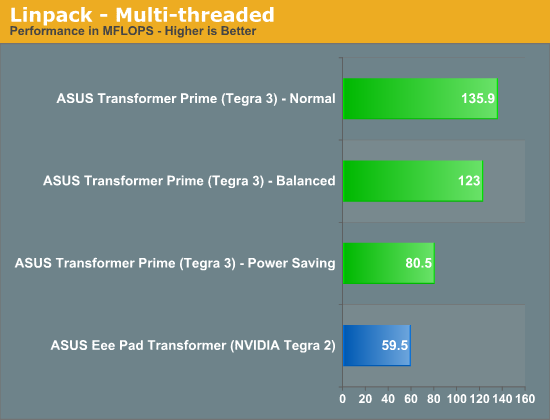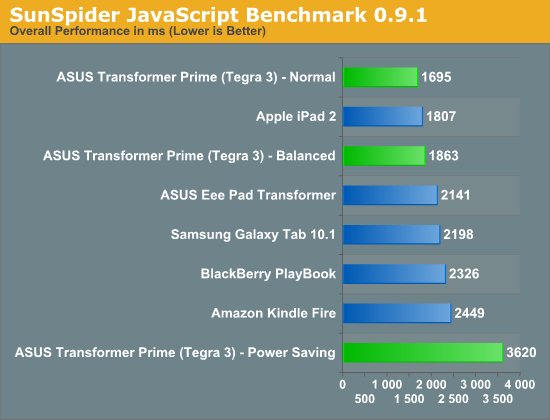ASUS Eee Pad Transformer Prime & NVIDIA Tegra 3 Review
by Anand Lal Shimpi on December 1, 2011 1:00 AM ESTCPU Performance
The big news with Tegra 3 is that you get four ARM Cortex A9 cores with NEON support instead of just two (sans NEON) in the case of the Tegra 2 or most other smartphone class SoCs. In the short period of time I had to test the tablet I couldn't draw many definitive conclusions but I did come away with some observations.
Linpack showed us healthy gains over Tegra 2 thanks to full NEON support in Tegra 3:


As expected, finding applications and usage models to task all four cores is pretty difficult. That being said, it's not hard to use the tablet in such a way that you do stress more than two cores. You won't see 100% CPU utilization across all four cores, but there will be a tangible benefit to having more than two. Whether or not the benefit is worth the cost in die area is irrelevant, it only means that NVIDIA (and/or its partners) have to pay more as the price of the end product to you is already pretty much capped.


The bigger benefit I saw to having four cores vs. two is that you're pretty much never CPU limited in anything you do when multitasking. Per core performance can always go up but I found myself bound either by the broken WiFi or NAND speed. In fact, the only thing that would bring the Prime to a halt was if I happened to be doing a lot of writing to NAND over USB. Keyboard and touch interrupts were a low priority at that point, something I hope to see addressed as we are finally entering the era of performance good enough to bring on some I/O crushing multitasking workloads.

Despite having many cores at its disposal, NVIDIA appears to have erred on the side of caution when it comes to power consumption. While I often saw the third and fourth cores fire up when browsing the web or just using the tablet, NVIDIA did a good job of powering them down when their help wasn't needed. Furthermore, NVIDIA also seems to prefer running more cores at lower voltage/frequency settings than fewer cores at a higher point in the v/f curve. This makes sense given the non-linear relationship between voltage and power.
From a die area perspective I'm not entirely sure having four (technically, five) A9 cores is the best way to deliver high performance, but without a new microprocessor architecture it's surely more efficient than just ratcheting up clock speed. I plan on providing a more thorough look at Tegra 3 SoC performance as I spend more time with a fixed Prime, but my initial impressions are that the CPU performance isn't really holding the platform back.










204 Comments
View All Comments
mcnabney - Thursday, December 1, 2011 - link
"Android File Transfer won't push over a file greater than 4GB"That means don't expect to stream HD content off of a home server/computer. Heck, uncompressed DVD-quality might not fit. Massive fail!!!!! Looks like a tablet is still not in my future. Maybe next time the industry tries to make a 'media consumption device' they will do something to allow it to consume media.
name99 - Thursday, December 1, 2011 - link
"Maybe next time the industry tries to make a 'media consumption device' they will do something to allow it to consume media."The bulk (BY FAR) of "the industry" is Apple. As far as I know, iPad handles larger than 4GB files (h264 or otherwise) without a problem.
(I think there is a problem with very large AAC files, but this is a problem with the AAC spec, not with the file size --- you get problems when the number of samples in the file exceeds around 2^31, which happens at around 14hrs for 44k samples/sec.
This appears on other platforms as well, so I'm guessing the container file spec has a 31 or 32 bit field somewhere in it.)
vvk - Thursday, December 1, 2011 - link
4GB is the limit for FAT - if you have exFAT or NTFS formated card should work with no problem.Death666Angel - Thursday, December 1, 2011 - link
"That means don't expect to stream HD content off of a home server/computer." Streaming should not be affected by the file system limitation, because it streams the content and doesn't save it on the device.lordmetroid - Thursday, December 1, 2011 - link
Can I install another operating system of my choice?Omid.M - Thursday, December 1, 2011 - link
Just held the galaxy tab 8.9 and I think its the perfect size.Likelihood that Asus would release a Prime in that size?
Nice review. ICS and 8.9 screen would've sold me.
@moids
joe_dude - Thursday, December 1, 2011 - link
Anand, will you do a short review when the ICS comes out in January?Thanks for the late-night comment responses, BTW. :)
Anand Lal Shimpi - Thursday, December 1, 2011 - link
Absolutely :) Expect to see Brian Klug's first thoughts on ICS before then though :)Take care,
Anand
tipoo - Friday, December 2, 2011 - link
Good to know, I don't think Honeycomb is well optimized for multicore, ICS sees some nice improvents across the board on them so the Tegra 3 should really shine more once it gets upgraded.isorashi - Thursday, December 1, 2011 - link
My sisters and I are planning on getting my mom a tablet for xmas. She's pretty clueless when it comes to computers -- she can turn one on and start skype, but she needs my dad to check fb / email for pictures of the grand-kids.The choice basically comes down to android vs ios. Transformer Prime in one case, iPad 2 in the other. Personally, I'm leaning towards the android because I have a better idea of what's going on there in case they need help. Plus I like the idea that it can easily interface with their Win7 pc to transfer pictures and what-not. That actually is a statement against the iPad -- I'm very VERY reluctant to inflict iTunes on my parents :-/